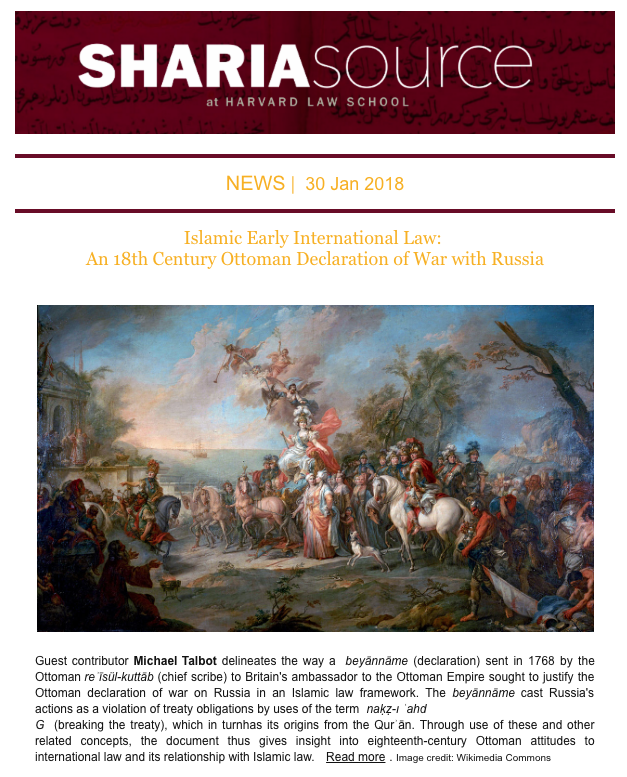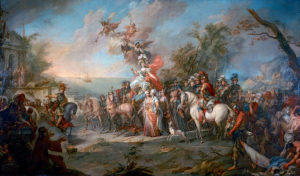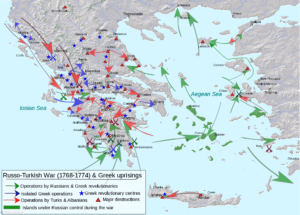
 Islamic Early International Law: An 18th Century Ottoman Declaration of War with Russia Guest contributor Michael Talbot delineates the way a beyānnāme (declaration) sent in 1768 by the Ottoman reʾīsül-kuttāb (chief scribe) to Britain’s ambassador to the Ottoman Empire sought to justify the Ottoman declaration of war on Russia in an Islamic law framework. The beyānnāme cast Russia’s actions as a violation of treaty obligations by uses of the term naḳẓ-ı ʿahd G (breaking the treaty), which in turn has its origins from the Qurʾān. Through use of these and other related concepts, the document thus gives insight into eighteenth-century Ottoman attitudes to international law and its relationship with Islamic law. Image credit: Wikimedia Commons
Islamic Early International Law: An 18th Century Ottoman Declaration of War with Russia Guest contributor Michael Talbot delineates the way a beyānnāme (declaration) sent in 1768 by the Ottoman reʾīsül-kuttāb (chief scribe) to Britain’s ambassador to the Ottoman Empire sought to justify the Ottoman declaration of war on Russia in an Islamic law framework. The beyānnāme cast Russia’s actions as a violation of treaty obligations by uses of the term naḳẓ-ı ʿahd G (breaking the treaty), which in turn has its origins from the Qurʾān. Through use of these and other related concepts, the document thus gives insight into eighteenth-century Ottoman attitudes to international law and its relationship with Islamic law. Image credit: Wikimedia Commons
 An Ottoman-Islamic Declaration of War against Russia, 1768 This document is a beyānnāme , or declaration, sent by Recāī Efendi, the Ottoman reʾīsül-kuttāb (chief scribe), to Britain’s ambassador to the Ottoman Empire. It justifies the Ottoman declaration of war on Russia by casting Russia’s actions as a violation of treaty obligations, giving insight into eighteenth-century Ottoman attitudes to international law and its relationship with Islamic law. Image credit: Wikimedia Commons
An Ottoman-Islamic Declaration of War against Russia, 1768 This document is a beyānnāme , or declaration, sent by Recāī Efendi, the Ottoman reʾīsül-kuttāb (chief scribe), to Britain’s ambassador to the Ottoman Empire. It justifies the Ottoman declaration of war on Russia by casting Russia’s actions as a violation of treaty obligations, giving insight into eighteenth-century Ottoman attitudes to international law and its relationship with Islamic law. Image credit: Wikimedia Commons
 Webb v. City of Philadelphia (3d Cir. 2009): Ḥijāb with Police Uniform In recent developments in law and religion in U.S. law, female Muslim police officer Kimberlie Webb sued the City of Philadelphia under Title VII and the Pennsylvania Religious Freedom Protection Act. Alleging religion- and gender-based discrimination, she objected to the City barring her from wearing a headscarf ( ḥijāb ) with her police uniform, and argued that the prohibition amounted to a failure to accommodate her right to free exercise of religion under the First Amendment. The City argued that the bar was consistent with Philadelphia Police Directive 78 and that allowing her to wear religious garb would cause an undue burden on the City and the Police Department, in that it would compromise a look of cohesiveness and uniformity among officers. Find out how the Courts decided the case. Read more. Image credit: Wikimedia
Webb v. City of Philadelphia (3d Cir. 2009): Ḥijāb with Police Uniform In recent developments in law and religion in U.S. law, female Muslim police officer Kimberlie Webb sued the City of Philadelphia under Title VII and the Pennsylvania Religious Freedom Protection Act. Alleging religion- and gender-based discrimination, she objected to the City barring her from wearing a headscarf ( ḥijāb ) with her police uniform, and argued that the prohibition amounted to a failure to accommodate her right to free exercise of religion under the First Amendment. The City argued that the bar was consistent with Philadelphia Police Directive 78 and that allowing her to wear religious garb would cause an undue burden on the City and the Police Department, in that it would compromise a look of cohesiveness and uniformity among officers. Find out how the Courts decided the case. Read more. Image credit: Wikimedia
See the full newsletter.

